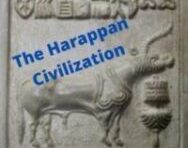
Indus Valley Civilization | Ancient History Short Notes
Indus Valley Civilization notes/study material for preparation of UPSC, BPSC, UPPSC and other State PSC Examinations.
Home » UPSC Study Materials » Prelims Express » Ancient History Short Notes » Pre Historic Period | Ancient History Short Notes
Pre-Historic Period short notes for preparation of UPSC, BPSC, UPPSC and other Examinations.
We the humans have a long past of evolution. The earliest traces of human existence in India go back to the period between 300000 and 200000 BC.
We have evolved a lot since then slowly and gradually.
However, Most of this process of evolution is not recorded or written anywhere as the humans of that time did not know how to write.
It is only after the humans learnt the skill of writing, they started recording thing in written format for the reference of future generations.
So broadly we can divide the history of human evolution into two parts :
So, to conclude, the history of human past before the emergence of writing is called prehistoric period.
As there are no written records are available for this period, Our study of this period is mainly based on the archaeological remains ( Ex.- Stone tools, Pottery, Artifacts) that have been excavated by the archaeologist. Such archaeological remains are found in different parts of India which help us in reconstructing the history of this time.
Prehistoric period has been divided into various stages/ages on the basis of nature and types of stone implements used by the primitive men.
Initially, the stone implements used by primitive men were large and rough. With the passage of time, there was a remarkable improvement in the stone tools. We will learn about this transformation in detail.
In India, the prehistoric period/Stone Age is divided into :
Metal Age in India was a transitional phase from Pre-historic period to historic period.
These periods were not uniform throughout the Indian subcontinent.
Let’s study them one by one in detail.
 The word Paleolithic comes from two Greek words, ‘Palaeo’, meaning old, and ‘Lithos’, meaning stone. Hence the name Old Stone Age. The name itself points to the importance of stone tools that were found during this period.
The word Paleolithic comes from two Greek words, ‘Palaeo’, meaning old, and ‘Lithos’, meaning stone. Hence the name Old Stone Age. The name itself points to the importance of stone tools that were found during this period.
The Paleolithic period extends from 2 million years ago to about 12,000 years ago. It has been further divided into the Lower Paleolithic, Middle Paleolithic and Upper Paleolithic ages which indicate slow and gradual increase in fineness of the stone tools.
Stone implements were generally made of a hard rock known as Quartzite. Therefore Paleolithic man in India is also called Quartzite Man.
The life of Paleolithic people was primitive. For their food requirements, they were totally dependent on hunting and gathering of edible things provided by nature(fruits, vegetables, roots, seeds, leaves etc.). They moved from place to place in search of such plant and animal resources. Therefore, these people were also called hunter-gatherers.
They lived in rock shelters and caves. Many of the caves in which these early people lived have beautiful paintings on the walls.
Some of the best examples of Paleolithic paintings are from Bhimbetka located in Madhya Pradesh. Paintings in Bhimbetka show wild animals and hunting scenes drawn with great accuracy and skill.
It was the transitional phase between the Paleolithic Age and Neolithic Age which falls roughly from 12000 B.C. to 6000 B.C.
During Mesolithic period, favorable changes happened in the climate.
The climate became warmer and humid which was favorable for growth of vegetation. This led to the natural growth of several grain bearing grasses such as wheat and barley in different parts of the India. Human beings collected these grains as food, and with time also learnt where they grew, and when they ripened and became edible.
Therefore we can safely conclude that primitive cultivation started during this period and with that started the tendency to settle for longer periods in an area.
Domestication of animals also started during this period.
Earliest evidence of domestication of animals is found from Adamgarh in Madhya Pradesh and Bagor of Rajasthan.
Evidence found at these places suggest that dog, cattle, sheep and goat were some of the first animals to be domesticated.
People of Mesolithic period were aware of burial process of dead bodies.
Mesolithic human burials have been found at Langhnaj in Gujarat, Bagor in Rajasthan, Bhimbetka in Madhya Pradesh, SaraiNahar Rai and Mahdaha of Pratapgarh district of UP.
Neolithic Age began around 6000 B.C . A remarkable progress was noticed in human civilization in the Neolithic Age.
The chief characteristic features of Neolithic culture is the beginning of agriculture. Cultivation of plants and domestication of animals led to the emergence of village communities based on sedentary life.
Oldest evidence of Agriculture is found in Mehrgarh in Baluchistan.
Oldest evidence of Paddy Cultivation is found in Koldihawa in Allahabad District of UP.
Domestication and rearing of sheep, goats and cattle was widely prevalent. Cattle were used for cultivation and for transport
Stone tools of the Neolithic period were polished to give a fine cutting edge. They were found to be more effective for hunting and cutting trees.
Invention of the Potter’s Wheel was one of the most important technological advancements of this time. Pottery was used for cooking as well as storage of food grains. These were also decorated sometimes.
Large urns were used as coffins for the burial of the dead.
People of Neolithic period started growing Cotton.
Earliest evidence of Cotton cultivation has been found at Mehrgarh, Pakistan.
The people of Neolithic Age used clothes made of cotton and wool.
People of Neolithic period made mud brick houses instead of grass huts.
At some places, people built pit-houses which were dug into the ground (For example in Burzahom , Kashmir) with steps leading into them.
The Neolithic period was followed by the Chalcolithic/Metal age. It was the time when humans began using metals along with stones. First metal used by humans was Copper. Hence this age was also called the ‘Copper-Stone’ age. Bronze was also used along with copper to make tools and weapons.
In this period, Humans learnt the technology of smelting metal ore and crafting metal artifacts. People began to travel for a long distance to obtain metal ores. This led to a network of Chalcolithic cultures throughout the Indian subcontinent.
Generally, Chalcolithic cultures had grown along the river valleys. Some important Chalcolithic cultures are :
Harappan culture is also considered as a part of Chalcolithic culture. However, there are many Chalcolithic sites which belong to the Pre-Harappan and Post-Harappan period.
With this, We have completed the study of Pre-Historic period.
Revision is the key to success in Civil Services exam. We understand this very well. Therefore we have included a list of MCQs with detailed explanation.
In the next post, we will study about the Indus valley civilization.

Indus Valley Civilization notes/study material for preparation of UPSC, BPSC, UPPSC and other State PSC Examinations.

Vedic Literature notes/study material for preparation of UPSC, BPSC, UPPSC and other State PSC Examinations.

Rig Vedic / Early Vedic Period notes/study material for preparation of UPSC, BPSC, UPPSC and other State PSC Examinations.

Later Vedic Period notes/study material for preparation of UPSC, BPSC, UPPSC and other State PSC Examinations.
We are adding new Notes, Chapterwise MCQs, Quizzes, Previous Years Questions everyday
We are adding new Notes, Chapterwise MCQs, Quizzes, Previous Years Questions everyday